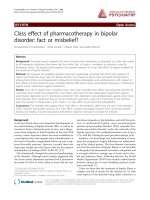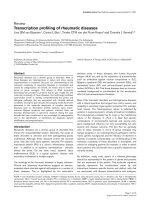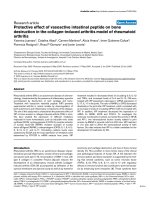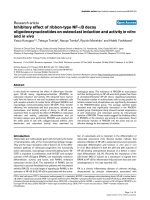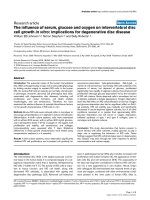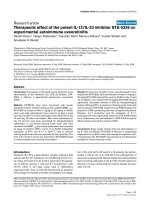Báo cáo y học: "The effect of continuous positive airway pressure (CPAP) on renal vascular resistance: the influence of renal denervation" doc
Bạn đang xem bản rút gọn của tài liệu. Xem và tải ngay bản đầy đủ của tài liệu tại đây (129.54 KB, 5 trang )
The effect of continuous positive airway pressure (CPAP) on
renal vascular resistance: the influence of renal denervation
Rose A Sharkey, Eithne MT Mulloy, Michelle Long and Shane J O’Neill
Objective: To non-invasively study the effects of continuous positive airway
pressure breathing (CPAP) on renal vascular resistance in normal subjects and
renal allograft recipients, in other words those with with denervated kidneys. We
could then ascertain the influence of renal innervation on any resulting changes
in renal haemodynamics.
Methods: Ten healthy volunteers and six renal transplant patients were studied.
Using Doppler ultrasonography, the pulsatility index (PI), an index of renovascular
resistance, was measured at incremental levels of CPAP (0, 2.5, 5.0 and
7.5cmH
2
O).
Results: In both groups, the PI increased significantly between 0 and
5.0cmH
2
O CPAP, with a further increase at 7.5 cmH
2
O CPAP.
Conclusions: We found that CPAP at 5.0 and 7.5cmH
2
O caused a significant
increase in renovascular resistance in both normal and renal transplant patients.
There was no difference in the degree of rise in renovascular resistance between
both groups, indicating that the renal nerves do not play a role in altering renal
vascular resistance with the application of CPAP.
Address: Department of Respiratory Medicine,
Beaumont Hospital, Dublin 9, Ireland.
Correspondence: Dr Shane O’Neill, Department
of Respiratory Medicine, Beaumont Hospital,
Dublin 9, Ireland. Tel: 01 8377755;
fax: 01 8376982
Keywords: continuous positive airway pressure,
renal denervation, renal vascular resistance
Received: 11 February 1998
Revisions requested: 27 April 1998
Revisions received: 17 June 1998
Accepted: 9 February 1999
Published: 16 March 1999
Crit Care 1999, 3:33–37
The original version of this paper is the electronic
version which can be seen on the Internet
(). The electronic version may
contain additional information to that appearing in
the paper version.
© Current Science Ltd ISSN 1364-8535
Research paper 33
Introduction
Continuous positive airway pressure (CPAP) is used in
the treatment of obstructive sleep apnoea, adult respira-
tory distress syndrome (ARDS), chronic obstructive pul-
monary disease (COPD) and acute cardiogenic pulmonary
oedema [1]. Many patients on positive pressure ventila-
tion, especially with the addition of positive end-expira-
tory pressure (PEEP), develop fluid retention and
impaired renal function [2,3] and PEEP is known to
reduce urinary output and sodium excretion [2,4].
Reduced renal blood flow has been implicated as a possi-
ble mechanism for the development of fluid retention [5].
This fall in renal blood flow may be secondary to a reduc-
tion in cardiac output, or inceased renal venous pressure
and redistribution of renal blood flow from cortical to
medullary regions [6]. Sympathetic activation acting
directly via renal nerve stimulation or indirectly via nor-
adrenaline release may also play a role [7,8]. The fall in
renal blood flow secondary to the application of PEEP in
dogs is abolished by renal denervation, suggesting a major
modulatory role for renal innervation. Fluid retention also
occurs with CPAP, but the extent of changes in renal
haemodynamics with CPAP are unknown.
We studied a group of normal volunteers to determine
possible effects of CPAP on distal renovascular resistance.
This is an indirect assessment of changes in renal blood
flow. We then compared these findings to those from a
group of patients post renal transplantation, in other words
with renal denervation. By comparing these two groups,
we could determine the influence of renal innervation on
any resulting alterations in renal haemodynamics.
Methods
Subjects
Ten normal subjects and six renal transplant patients
were studied. All participants were male. Each subject
gave informed consent and the hospital ethics commit-
tee approved the study. The normal subjects were
recruited from the medical staff with a mean±SD age of
24±1.56 years and none of them were on medication. Six
male patients with renal allografts for treatment of
chronic renal failure were randomly recruited from the
nephrology outpatient department. They were at least
18 months post renal transplantation (mean 30 months)
with an average age of 37.7±4.27 years. Each patient had
a stable renal function, with serum creatinine level
<200mmol/l and no recent renal complications. All
patients were on immunosuppressive therapy which
included prednisolone, azothioprine and cyclosporin.
Seven of the patients were on antihypertensive medica-
tion, consisting of a beta-blocker in five cases and
nitrates in two. None of them had a history of cardiac or
respiratory disease.
Each subject was studied at a similar time each day. CPAP
was delivered via tight-fitting full-face mask by a continu-
ous-flow system using a Downs flow generator (Vital
Signs, Boston, Massachusetts, USA). CPAP was started at
a level of 2.5cmH
2
O and increased by increments of
2.5cmH
2
O to a maximum of 7.5cmH
2
O. CPAP was
applied for 20min at each of the three sequential pressure
settings.
Ultrasonography
Doppler ultrasound examinations were performed using
an Acuson 128 realtime ultrasound scanner (Acuson Cor-
poration, Mountain View, California, USA) with pulsed
Doppler and colour-flow facilities [9]. A 2MHz probe was
used. Each subject rested for 15min before being
scanned. In the normal subjects, the right kidney was
scanned in the longitudinal plane via the translumbar
route, with the subject in the seated position. The trans-
planted kidney was scanned via the transabdominal route,
with the patient supine. A renal interlobar artery was iden-
tified both from its anatomical position and typical sono-
gram showing the characteristic high diastolic blood
velocity. The angle of the ultrasound beam was adjusted
until the maximum Doppler frequency shift was obtained.
The pulsatility index (PI) was calculated using the inte-
grated computer software. The PI is obtained by calculat-
ing the difference between the peak systolic frequency
shift of the Doppler spectrum (A) and the end-diastolic
frequency shift (B), which is then divided by the mean
frequency shift (mean), such that PI=A–B/mean [10]. PI
is an index of distal resistance to flow in the vascular bed;
the lower the PI, the less the resistance to flow and there-
fore the greater the rate of flow. The PI is independent of
the vessel diameter and the angle between the Doppler
beam and the vessel axis. There was little variation in the
PI with each arterial pulsation, and the mean of a
minimum of three PI measurements from the same inter-
lobar artery was calculated at each time point. Heart rate
and blood pressure were monitored throughout the study.
Validation
The PI has been validated in healthy volunteers [11].
Using dopamine and dobutamine to vary renovascular
resistance, changes in renal vascular resistance (measured
by classical methodology) correlated strongly with those in
the PI [11]. A further study showed that the both the PI
and resistive index (RI) correlated significantly with effec-
tive renal plasma flow, renal vascular resistance, filtration
fraction and clearance of creatinine [12]. In a study of
renal haemodynamics in COPD, PI and Tamx (mean of
the maximum instantaneous flow) were used [13] and all
the subjects increased their Tamx and had a simultaneous
decrease in their PI in response to inhaled oxygen, sug-
gesting that both parameters are equally sensitive to
changes in renal haemodynamics in COPD. In our centre,
the coefficient of variation of PI is 2.05% [9].
Statistics
The PI measurements during the different levels of CPAP
were compared using the Friedman test for non-paramet-
ric data. The Dunn’s multiple comparison test was used,
where appropriate, to determine at which levels the
changes in PI were significant. Numerical variables were
compared between the controls and renal transplant sub-
jects by the Wilcoxon test for non-parametric data. The
results are given as mean±SD, and a P level less than 0.05
was considered significant.
Results
The mean age of the normal subjects was 24±1.56 years
and 37.7±4.27 years in the renal transplant subjects
(P<0.01). There was a significant rise in the mean PI in
the controls with the addition of CPAP (P<0.001; Table 1,
Fig 1). Using non-parametric testing, there was no signifi-
cant change in PI between 0 and 2.5cmH
2
O CPAP
(Table 1). However, between 0 and 5.0cmH
2
O CPAP, PI
increased from 0.65±0.06 to 0.7±0.08 (P<0.05), indicating
that the application of CPAP caused an increase in renal
vascular resistance and therefore a fall in renal blood flow.
This increase in PI occurred in all except one subject.
Between 0 and 7.5cmH
2
O CPAP, there was a further rise
in PI in all normal subjects to a mean of 0.82±0.08
(P<0.01). The increase in PI between 5.0 and 7.5cmH
2
O
CPAP was also significant (P<0.05). The increase in PI
was usually evident within 10min of the application of
CPAP. The renal transplant subjects had a higher baseline
PI than the normal subjects (1.15±0.18 compared to
0.65±0.06, P<0.05; Table 1). The PI increased signifi-
cantly in all the transplant subjects with 5.0 and
7.5cmH
2
O CPAP (Table 1, Fig 1).
We compared the rise in PI with the application of CPAP
between the normal and transplant subjects (Table 1).
34 Critical Care 1999, Vol 3 No 1
Table 1
The pulsatility index (PI) at baseline and during continuous
positive airway pressure (CPAP) in normal and transplant
subjects
PI in controls PI in transplant
CPAP (cmH
2
O) (n=10) subjects (n=6) P
†
0 0.65±0.06 1.15±0.18 <0.05
2.5 0.64±0.08
5.0 0.70±0.08* 1.24 ± 0.2* <0.05
7.5 0.82±0.08** 1.37 ± 0.24** <0.05
Change from 0–5.0 0.048±0.03 0.096±0.04 NS
Change from 0–7.5 0.17 ± 0.06 0.23 ± 0.09 NS
†
Differences between the two groups. Change from 0–5.0 refers to the
change in PI beween 0 and 5.0cmH
2
O CPAP, while change from
0–7.5 refers to the change in PI beween 0 and 7.5cmH
2
O CPAP.
*P<0.05, **P<0.01, versus 0cmH
2
O CPAP; NS, not significant.
The increase in PI in response to 5.0cmH
2
O CPAP was
greater in the transplant subjects but this was not signifi-
cant. Furthermore, there was no difference between the
groups in the response to 7.5cmH
2
O CPAP. However,
when expressed in terms of percentage change in PI
from baseline values, the increase in PI with 5.0cmH
2
O
was 7.7% in controls compared to 7.8% in the transplant
subjects and, with 7.5cmH
2
O CPAP, the increase was
26% in the controls compared to 20% in the transplant
subjects.
Systolic blood pressure did not change in the controls
between 0 and 5.0cmH
2
O CPAP (115±9.26mmHg and
109±8.63mmHg, respectively; NS). However, the systolic
blood pressure fell to 104±11.0mmHg on 7.5cmH
2
O
CPAP, which approached statistical significance (P=0.06).
Diastolic blood pressure fell significantly on 7.5cmH
2
O
CPAP, from 76.43±8.84mmHg at baseline to
72.9±9.32mmHg (P<0.01). In the transplant subjects,
there was no significant change in either systolic or dias-
tolic blood pressure during the application of CPAP. Fur-
thermore, there was no significant change in heart rate in
all patients throughout the study.
Discussion
This study looked at the effect of a short period of CPAP
on renal vascular resistance in both normal and renal trans-
plant subjects. We found that increasing levels of CPAP to
7.5cmH
2
O caused a significant increase in renovascular
resistance, suggesting a fall in renal blood flow. This was
found in both normal subjects and renal transplant
patients, suggesting that the renal nerves do not play a
role in altering renal haemodynamics secondary to the
application of CPAP.
The primary aim of this study was to determine the
changes in renal haemodynamics in response to varying
levels of CPAP. The secondary aim was to look at the pos-
sible role of the renal nerves in such changes. Thus, we
studied patients with renal transplants to determine
whether denervation abolished the renovascular responses.
Previous studies have looked at renal nerve regeneration
in both animals and humans post renal transplantation.
Histological studies have shown evidence of partial regen-
eration in human renal transplant recipients [14].
However, a recent study has shown that, despite this
regeneration, the human transplanted kidney remains
functionally denervated [15].
Previous animal and human studies have shown conflict-
ing results on the effect of both CPAP and PEEP on renal
haemodynamics [8,16–20]. The majority of these studies
found a decrease in renal blood flow with the application
of positive pressure ventilation [8,16,18,19]. However,
Berry et al [17] found no change in renal blood flow in
dogs following the application of 10cmH
2
O PEEP. More
recently, Andrivet et al [20] also found no alteration in
renal blood flow in a group of patients on applying
10cmH
2
O PEEP [20]. There are several possible explana-
tions for these inconsistent findings. The most likely
explanation is the difference in the intravascular volume
of the subjects in the studies. In the study by Berry et al
[17], the dogs had developed significant fluid retention
prior to the measurement of renal blood flow and the
cardiac index actually increased with the application of
PEEP and, subsequently, the renal blood flow remained
constant. In the majority of the other studies, the subjects
were normovolaemic and had a fall in stroke volume sec-
ondary to CPAP/PEEP with a subsequent fall in renal
blood flow [8,18,19]. Another possible factor may be the
redistribution of renal blood flow with the introduction of
positive pressure ventilation. Hall et al [21] found a redis-
tribution in renal blood flow from the outer to inner cortex
secondary to PEEP. The degree of this intrarenal redistri-
bution would have a significant effect on the total renal
blood flow. Finally, both the level of CPAP and PEEP and
the length of time they were applied varied significantly
in the previous studies and these two factors would allow
hormones such as antidiuretic hormone (ADH) and aldo-
sterone to have an effect on the resultant renal haemody-
namics [16].
It was thought that both PEEP and CPAP affect renal
haemodynamics indirectly by reducing cardiac output.
PEEP results in a higher mean intrathoracic pressure than
CPAP [22], thus leading to a greater fall in cardiac output
and ultimately affecting renal blood flow to a greater
degree than CPAP. Several studies have shown that both
PEEP [16] and CPAP [23] cause a decrease in cardiac
output in controls, and this is thought to occur because of
reduced venous return secondary to increased intrathoracic
Research paper Effect of CPAP on renal vascular resistance Sharkey et al 35
Figure 1
Pulsatility index at the different levels of continuous positive airway
pressure (CPAP) in all subjects (black bars, controls; grey bars,
transplant subjects
0
0.2
0.4
0.6
0.8
1
1.2
1.4
1.6
Rest
2.5 CPAP 5.0 CPAP 7.5 CPAP
Pulsatility Index
pressure. However, this has not been confirmed in other
studies. Leech and Ascah [24] found no effect on cardiac
output in a group of normal subjects following the applica-
tion of 15cmH
2
O nasal CPAP. Furthermore, Bradley et al
[25] found that in 22 patients with congestive heart
failure, the cardiac output increased with CPAP in the
group with raised pulmonary capillary wedge pressure,
whilst it fell in those with normal wedge pressures. They
attributed the improved cardiac output in those with high
wedge pressure to a reduction in left ventricular afterload
secondary to the increase in intrathoracic pressure with
CPAP. There are several possible explanations for the dif-
fering results found in these studies. These include differ-
ent modes of CPAP application (such as face-mask versus
nasal CPAP) [23], different methods of measuring the
resultant effect on cardiac function and the possibility that
volume loading in some of the studies influenced the
resultant effect on cardiac function [26].
The mechanism for the change in renal haemodynamics
in our subjects is unclear. Renal blood flow is dependent
on both perfusion pressure and renal vascular resistance,
both of which may be altered by CPAP. An increase in
intrathoracic pressure results in a fall in venous return
which causes an increase in renal venous pressure, leading
to a rise in the renal vascular resistance and a subsequent
fall in renal blood flow. Also, a fall in venous return sec-
ondary to increased intrathoracic pressure leads to a fall in
cardiac output which results in an increase in renal vascu-
lar resistance and therefore a decrease in renal blood flow.
We recorded the cardiac output in three normal subjects
and five transplant subjects and found a significant fall in
cardiac output with both 5.0 and 7.5cmH
2
O CPAP.
However, since we did not record the renal venous pres-
sure, we cannot state whether the increase in renal vascu-
lar resistance was secondary to a change in renal venous
pressure or to a change in cardiac output.
Renal denervation has been found to abolish the fall in
renal blood flow secondary to the application of PEEP in
dogs, suggesting that the renal nerves play a significant
role in determining the renal haemodynamic response to
positive pressure breathing in dogs [27]. Jacob et al [28]
have looked at the effect of PEEP on renal haemodynam-
ics in a group of patients immediately post renal transplan-
tation. They found no significant difference in renal blood
flow between zero end-expiratory pressure (ZEEP) and
15cmH
2
O PEEP [28]. These findings contradict our find-
ings. A number of differences between the two studies
may explain the different findings. Firstly, we studied a
group of subjects who were at least 18 months post renal
transplantation, with stable renal function. Jacob et al
carried out their study on subjects immediately post-trans-
plantation. There is a higher level of circulating hormones
and neuropeptides, especially noradrenaline, immediately
post-surgery and these could have an effect on the
response of the renal blood flow to PEEP [29]. Secondly,
their results may have been affected by anaesthetic agents
and by the continuous infusion of dopamine given during
the transplant surgery [30]. Thirdly, ischaemic reperfusion
injury may have affected the response to PEEP. Finally,
and most importantly, their subjects were studied 1h post-
operatively and were volume loaded during the procedure
(subjects received 5l saline, albumin and 5 units of packed
red blood cells) and this could have prevented the fall in
renal blood flow secondary to PEEP. This contrasts with
our subjects who were euvolumic.
In summary, the application of CPAP at 5.0 and
7.5cmH
2
O caused a significant increase in renovascular
resistance in both normal subjects and renal transplant
subjects. The rise in renovascular resistance was greater
with the higher level of CPAP. There was no difference in
the extent of the increase in renovascular resistance in
response to CPAP between both groups suggesting that
the renal nerves do not play a role in altering renal vascu-
lar resistance with the application of CPAP.
References
1. Miro AM, Shivaram U, Hertig I: Continuous positive airway pressure
in COPD patients in acute respiratory failure. Chest 1993, 103:
266–268.
2. Berry AJ: Respiratory support and renal function. Anesthesiology
1981, 55:655–667.
3. Sladen A, Laver MB, Pontoppidan H: Pulmonary complications and
water retention in prolonged mechanical ventilation. N Engl J Med
1968, 279:448–452.
4. Priebe HJ, Hedley-Whyte J: Respiratory support and renal function.
Int Anaesthesiol Clin 1984, 22:203–225.
5. MacNee W: Pathophysiology of cor pulmonale in chronic obstruc-
tive pulmonary disease. Am J Respir Crit Care Med 1994, 150:
833–852, 1158–1168.
6. Albert RK: Non-respiratory effects of positive end-expiratory pres-
sure. Respiratory Care 1988, 33:464–471.
7. Payen DM, Brun-Buisson CJL, Carli PA, et al: Hemodynamic gas
exchange, and hormonal consequences of LBPP during PEEP
ventilation. J Appl Physiol 1987, 62:61–70.
8. Payen DM, Farge D, Beloucif S, et al: No involvement of antidiuretic
hormone in acute antidiuresis during PEEP ventilation in humans.
Anesthesiology 1987, 66:17–23.
9. Sharkey RA, Mulloy EMT, Kilgallen IA, O’Neill SJ: Renal functional
reserve in patients with severe chronic obstructive pulmonary
disease. Thorax 1997, 52:411–415.
10. Evans DH, McDicken WM, Skidmore R, Woodcock JP: Doppler ultra-
sound. physics, instrumentation and clinical applications.
11. Yura T, Yuasa S, Fukunaga M, Badr KF, Matsuo H: Role for Doppler
ultrasound in the assessment of renal circulation: effects of
dopamine and dobutamine on renal hemodynamics in humans.
Nephron 1995, 71:168–175.
12. Petersen LJ, Petersen JR, Ladefoged SD, Mehlsen J, Jensen HE: The
pulsatility index and the resistive index in renal arteries in patients
with hypertension and chronic renal failure. Nephrol Dial Transplant
1995, 10:2060–2064.
13. Baudouin SV, Bott J, Ward A, Deane C, Moxham J: Short term effect
of oxygen on renal haemodynamics in patients with hypoxaemic
chronic obstructive airways disease. Thorax 1992, 47:550–554.
14. Gazdar AF, Dammin GJ: Neural degeneration and regeneration in
human renal transplants. N Engl J Med 1970, 283:222–224.
15. Hansen JM, Abildgaard U, Fogh-Andersen N, Kanstrup IL, Bratholm P,
Plum I, Strandgaard S: The transplanted human kidney does not
achieve functional reinnervation. Clin Sci 1994, 87:13–20.
16. Annat G, Viale JP, Bui Xuan B, et al: Effect of PEEP ventilation on
renal function, plasma renin, aldosterone, neurophysins and
urinary ADH and prostaglandins. Anesthesiology 1983, 58:136–141.
36 Critical Care 1999, Vol 3 No 1
17. Berry AJ, Geer RT, Marshall C, Wu WH, Zbuzek VM, Marshall BE: The
Effect of long-term controlled mechanical ventilation with positive
end-expiratory pressure on renal function in dogs. Anesthesiology
1984, 61:406–415.
18. Gammanpila S, Bevan DR, Bhudu R: Effect of positive and negative
expiratory pressure on renal function. Br J Anaesth 1977, 49:
199–205.
19. Furzan JA, Gabriele G, Wheeler JM, Fixler DE, Rosenfeld CR:
Regional blood flows in newborn lambs during endotracheal con-
tinuous airway pressure and continuous negative pressure
breathing. Pediatr Res 1981, 15:874–878.
20. Andrivet P, Adnot S, Sanker S, et al: Hormonal interactions and
renal function during mechanical ventilation and ANF infusion in
humans. J Appl Physiol 1991, 70:287–292.
21. Hall SV, Johnson EE, Hedley-Whyte J: Renal hemodynamics and
function with continuous positive-pressure ventilation in dogs.
Anesthesiology 1974, 41:452–461.
22. Pesenti A, Marcolin R, Prato P, Borelli M, Riboni A, Gattinoni L: Mean
airway pressure vs. positive end-expiratory pressure during
mechanical ventilation. Crit Care Med 1985, 13:34–38.
23. Montner PK, Greene ER, Murata GH, Stark D, Timms M, Chick TW:
Hemodynamic effects of nasal and face mask continuous positive
airway pressure. Am J Respir Crit Care Med 1994, 149:1614–1618.
24. Leech J, Ascah KJ: Haemodynamic effects of nasal CPAP exam-
ined by Doppler echocardiography. Chest 1991, 99:323–326.
25. Bradley TD, Holloway RM, McLaughlin PR, Ross BL, Walters J, Liu PP:
Cardiac output responses to continuous positive airway pressure
in congestive heart failure. Am Rev Respir Dis 1992, 145:377–382.
26. Venus B, Mathru M, Smith R, Pham C, Shirakawa Y, Sugiura A: Renal
function during application of positive end-expiratory pressure in
swine: effect of hydration. Anesthesiology 1985, 62:765–769.
27. Fewell JE, Bond GC: Renal denervation eliminates the renal
response to continuous positive-pressure ventilation. Proc Soc
Exp Biol Med 1979, 161:574–578.
28. Jacob LP, Chazalet JA, Payen DM, et al: Renal hemodynamic and
functional effect of peep ventilation in human renal transplanta-
tions. Am J Respir Crit Care Med 1995, 152:103–107.
29. Lang R, Michels J, Becker-Berke R, Lukowski K, Vlaho V, Grundmann R:
Die sympathische Aktivitat bei terminaler Niereninsuffizienz und
Nierentransplantation. Klinische Wochenschrift 1984, 62:1025–1031.
30. Howes TQ, Deane CR, Levin GE, Baudouin SV, Moxham J: The
effects of oxygen and dopamine on renal and aortic blood flow in
chronic obstructive pulmonary disease with hypoxemia and
hypercapnia. Am J Respir Crit Care Med 1995, 151:378–383.
Research paper Effect of CPAP on renal vascular resistance Sharkey et al 37


